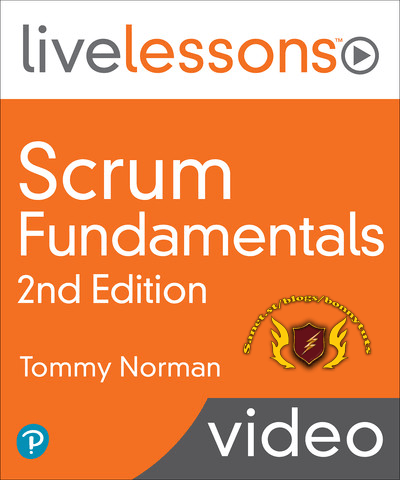
Released 1/2023
MP4 | Video: h264, 1280×720 | Audio: AAC, 44.1 KHz, 2 Ch
Genre: eLearning | Language: English | Duration: 4h 55m | Size: 1.51 GB
Overview
In this video training, Tommy Norman (CSM, A-CSM, CSPO, CSP, CTC, CEC, CAL, PSM, SAFe Agilist, Microsoft MVP) introduces Agile software development using Scrum, which is a lightweight, adaptive framework for managing complex projects. It consists of roles, artifacts, and events, as well as a simple set of rules to govern the relationships and interactions between them.
This course gives helpful insight into the history of Agile and how its values and principles can focus teams on consistently delivering quality products that immediately add value for the customer. It covers the complete Scrum framework from project initiation, executing Sprints, and delivering a product increment.
New content covers updates to the Scrum Guide and the body of knowledge from its creators, new techniques for implementing and scaling Scrum, and certifications that have emerged to support the growing adoption of Scrum. New content for this edition is covered in Lessons 7-10.
About the Instructor
Tommy Norman (CSM, A-CSM, CSPO, CSP, CTC, CEC, CAL, PSM, SAFe Agilist, Microsoft MVP) is the Chief Agility Officer at Acklen Avenue, a custom software development shop in Nashville, TN USA. With an IT career spanning almost 30 years, he has been helping organizations of all sizes and shapes build great software with a practical approach in a multitude of roles. He has worked deeply with the Agile community as the coordinator of the Agile Nashville user group, founder of the Music City Agile conference, as well as a frequent local and international speaker.
What You Will Learn
The history of Agile
The roles, artifacts, and events in Scrum
How to start a Scrum project
Essentials of writing good User Stories
How to maintain your Product Backlog and Release Plan
Agile estimation techniques
How to effectively plan for and execute a Sprint
Agile engineering best practices
How to integrate QA into your Sprints
How to inspect and adapt your process
Updates to the Scrum Guide
Certification options and benefits
Approaches to scaling Scrum
Who Should Take This Course
Anyone involved in the development of software applications looking for a practical introduction to the Agile framework Scrum.
Course Requirements
Familiarity with the basics of software development projects.
Lesson Descriptions
Lesson 1: A History of Agile
Lesson 1 covers a brief history of Agile and how it has evolved over the years. The lesson starts by reviewing how software had previously worked with a more traditional “Waterfall” approach. Viewers learn some of the intrinsic issues often encountered in Waterfall projects. From there, the lesson covers how Agile got its start and evolved into the many frameworks available today.
Lesson 2: Agile Concepts
Lesson 2 covers the underlying concepts behind many of the various Agile approaches. It discusses how to separate the implementation (or mechanism) of a concept from its underlying values and principles. Finally, the lesson touches on the many Agile processes and frameworks that have risen from these concepts and have become more mainstream today.
Lesson 3: An Overview of Scrum
Lesson 3 presents the basic roles, artifacts, and events that make up the Scrum framework. These topics are covered at a high level in this lesson and discussed in more depth in the following lessons.
Lesson 4: Starting a Scrum Project
Lesson 4 begins by demonstrating how to establish a Product Vision to act as a compass for the Scrum Team to follow. From there, it covers how to create the initial Product Backlog with good User Stories, and then how to prioritize it appropriately. Next, viewers learn how to assemble their Scrum Teams to best deliver their product increments. Viewers also learn the Agile concepts and techniques used for estimating User Stories and how to create a Release Plan to forecast when and what might be done in the future.
Lesson 5: Executing the Sprint
Lesson 5 shows how to start developing a product. It starts off by covering the Sprint Planning Meeting where the team determines what to work on, a Sprint goal is created, and a Sprint Backlog is developed, which is the plan for meeting that goal. The lesson then talks about how to work collaboratively as a Scrum Team. This lesson also covers the Daily Scrum, and it gives tips on how to make the most of this meeting. Finally, the lesson covers grooming the Product Backlog to keep a good runway of User Stories prepped and ready for the team.
Lesson 6: Ending the Sprint
Lesson 6 covers holding the Sprint Review and demoing the finished Product Increment to the stakeholders. Next, it talks about delivering that product increment to the users and how to do this as often as possible. Finally, the lesson discusses how to hold the Sprint Retrospective for the team to reflect and strive for continuous improvement.
Lesson 7: Scrum Guide Updates
Lesson 7 covers revisions to the Scrum Guide since the original version of Scrum Fundamentals LiveLessons released in 2015. Viewers learn the most significant changes and what they mean for Scrum in general.
Lesson 8: Scrum Certifications Overview
Lesson 8 gives an overview of Scrum certifications in the Agile community. This lesson discusses benefits from both the individual’s and company’s perspective.
Lesson 9: Scrum Scaling Approaches
Lesson 9 offers an overview of scaling frameworks for Scrum and discusses and how to choose the best option based on your organization’s needs.
Lesson 10: Next Steps
Lesson 10 presents resources for you to explore as you continue your Agile journey.
Password/解压密码www.tbtos.com
转载请注明:0daytown » LiveLessons – Scrum Fundamentals LiveLessons, 2nd Edition